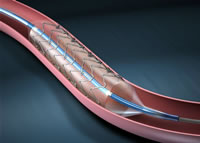| << To Blog Home >> | |
|
|
January 21, 2009 -- 12:20pm EST XIENCE V™ Stent Takes the Lead
The XIENCE V was approved by the FDA in July and is part of the new generation of stent technology, which I characterized last May as "DES 2.0", composed not just of new stent technologies, like XIENCE V and Medtronic's Endeavor, but a new way of looking at the process of stenting: when is it beneficial?, how to do it better?, how to verify proper placement?, etc. Interestingly enough, another company involved in DES 2.0 is Volcano. The company doesn't make stents, but innovates in imaging technologies like IVUS, OCT and Volcano also has been reporting double-digit growth, recently reporting a boost in sales of its FFR functional measurement products, due in great part to the striking results from the FAME trial. It seems that FFR (or Fractional Flow Reserve) is becoming a hot property in its own right -- St. Jude Medical just acquired Radi Systems, the other manufacturer of FFR devices. And more innovations will be coming: Abbott and others are working on biodegradable stents that will completely disappear when their work is done, Cardiac CT has made significant advances in lowering the radiation dose without compromising image quality and, in the near future, may be incorporating the ability to perform perfusion measurement, currently the territory of the nuclear stress test. Clearly the word for the future in healthcare is cost-effectiveness (well, okay, it's a hyphenated word...). But new technologies are going to have to prove that they can reduce costs AND benefit patient care. Of course, any advance in patient care will have the effect of reducing costs down the road (less repeat procedures, less care needed for chronic conditions, etc.). Whether innovation is enough to turn the economic tide, at least in the device industry, is yet to be seen, but these recent figures certainly are good news. |
|


